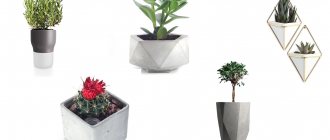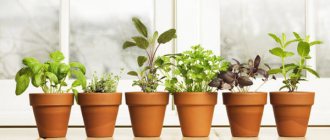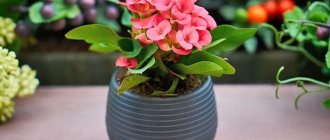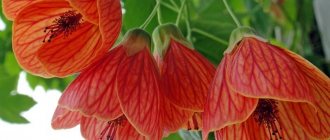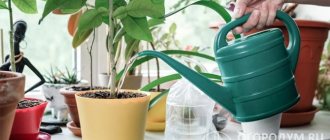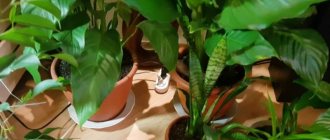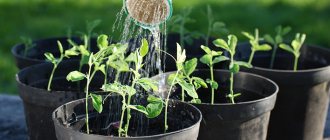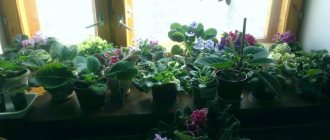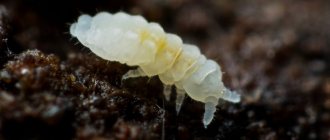Diffenbachia (Dieffenbachia)
The most common plant among home gardeners is a plant called Diffenbachia. Poisonous plant with large leaves. Born in North and South America in the Araceae family. Not all 52 species that have been bred to date live in indoor conditions. Let's talk about spotted dieffenbachia. The plant looks a little like a palm tree, a small palm tree, although in nature it can grow up to two meters in height. If you are a fan of drafts or simply constantly open the window due to hot heating in winter, you will not make friends with this plant. It does not like draft air and sudden temperature changes, like many indoor plants starting with the letter “D”. Be careful, the sap of this plant with its delicious, huge leaves is very poisonous. Be careful! Try to keep the plant warm, around average temperature, somewhere around 16-18 degrees Celsius. Moderate light is also needed. In hot summers the light is slightly below average, in winter it is bright. If there is too much of it, the plant may lose pigment and turn yellow. But you should not neglect water so that the edges of the leaves do not turn brownish. Many indoor plants starting with the letter “D” need similar care (you can study photos and names in various reference books). Soft and moist soil, periodic “bathing” of the plant, watering and wetting the leaves are important. The plant should be replanted every year; choose the time of year when the plant will be replanted; it is better to choose spring. Pests, leaf dieback... you need to be prepared for many difficulties if you like this plant.
Dieffenbachia - a guest from the tropics
Soil for indoor flowers. what soil should I use for plants?
This indoor flower with the letter “D” is found in the wild in the South American tropics, and in Russia it is a frequent guest among house plants. This perennial has a massive stem and large leaves, the colors of which are very diverse. The most common types are:
- dieffenbachia spotted;
- dieffenbachia variegated;
- Dieffenbachia Baumann.
Precious Ludisia: propagation and care at home
When caring for a flower, you will have to comply with some conditions, namely: do not allow the sun to hit the plant, but there must be a lot of light, otherwise the patterns on the leaves may disappear; sudden changes in temperature and drafts are unacceptable; In summer you need to maintain a temperature of about 23 degrees, in winter about 18 degrees. Soft settled or rainwater is suitable for irrigation.
In spring and summer, the soil should be moistened, and in winter the top layer of soil should dry out, and only then can the flower be watered. Once a week it is necessary to spray and wipe the leaves of Dieffenbachia with a damp cloth.
List of colors alphabetically from a to z
Twelve wonderful indoor plants
Names of flowers in alphabetical order by letter
- Radermacher
- Broom
- Rhubarb
- Reo, tradescantia reo
- Rhipsalidopsis, Easter cactus
- Robinia, Acacia
- Rogersia
- Rhodiola
- Rhododendron
- Rose, rosehip
- Roycissus
- Sundew
- Rudbeckia
- Rousselia, coral plant
- Ruellia
- Rowan
- Fieldfare
- Hazel grouse, fritillaria
- Cycad, Cycas
- Salpiglossis
- Boxwood
- Sanvitalia
- Sansevieria, pike tail, mother-in-law's tongue
- Sarracenia
- Safflower
- Plumbago
- Selaginella, the resurrection plant
- Saintpaulia, Usambara violet
- Setcreasia
- Sidalcea
- Siderasis
- Syngonium
- Feverweed
- Sinningia, Gloxinia
- Sinyukha, polemonium
- Lilac
- Sitnik
- Scabiosa, widow, bark bark
- Skimmia
- Scopolia
- Mackerel, yellowberry
- Plum, Prunus
- Smilatsina
- Currant
- Snowberry
- Snooze
- Saltirolia, Gelksina, Helksina
- Solnechnik, Heliopsis
- Sunflower
- Sorbocotoneaster
- Pine
- Sophora
- Sparmannia, indoor linden
- Spathiphyllum
- Spiraea, meadowsweet
- Sprekelia, sprekelia
- Stapelia
- Stahis
- Stefanandra
- Stephanotis, Madagascar jasmine
- Ostrich - fern
- Strelitzia, bird of paradise
- Arrowhead
- Streptocarpus, stemmed violet
- Strobilanthes
- Stromanta
- Sumac
- Sutera, bacopa
- Schizanthus, schizanthus
- Scaevola
- Scindapsus, Epipremnum
- Scirpus
- Tobacco
- Takka, bat
- Tamarix, comber
- Tetrastigma
- Tiarella, tiarka
- Tillandsia, Spanish, Louisiana moss
- Thyme, thyme
- Tiss
- Tithonia
- Tladianta
- Tolmia
- Bearberry
- Thick-walled
- Crassula, crassula, money tree
- Torenia
- Tradescantia
- Trillium
- Tritsirtis
- Thunbergia
- Thuja
- Pumpkin
- Yarrow
- Tulip
- Uvularia
- Phalaenopsis - orchid
- Fatsia, Aralia
- Fatshedera
- Violet, viola
- Physalis, flashlight
- Physostegia
- Ficus
- Philodendron
- Date fruit
- Fittonia
- Phlox
- Forsythia
- Fortunella, kincan, kumquat
- Phragmipedium - orchid
- Fuchsia
- Haworthia
- Hakonechloa
- Hamedorea
- Chamelacium, wax myrtle
- Hathiora
- Houttuinia, huttinia, houtinia
- Hebe
- Helona
- Chaenomeles, Japanese quince
- Hirita
- Chlorophytum
- Hop
- Hovea, Kentia
- Hoya
- Hosta, funkia
- Corydalis
- Chrysanthemum
- Chrysanthemum, dendranthemum
- Ceanothus, Redroot
- Coelogina - orchid
- Celosia
- Celosia
- Cereus
- Ceropegia
- Tsercis
- Cyanotis
- Cyclamen
- Cyclamen, dryweed, alpine violet
- Cymbidium - orchid
- Cohosh
- Cineraria
- Zinnia
- Cyperus, satiate
- Cissus, indoor ivy, birch
- Citrus
- Bird cherry
- Blueberry
- Chernogolovka, prunella
- Chokeberry, chokeberry
- China, sweet pea
- Mock orange, garden jasmine
- Sage
- Mulberry, Here
- Scheffler
- Rose stock, mallow, mallow, alcea
- Setaria, bristlecone
- Shield plant, dryopteris - fern
- Eucalyptus
- Edelweiss
- Eichornia, water hyacinth
- Exakum
- Endymion
- Evening primrose, night candle, aspen tree
- Aeonium
- Epipremnum
- Episcia
- Epiphyllum
- Eremurus, shiryash
- Erika
- Eschynanthus
- Eucomis, eucomis
- Eustoma, lisianthus, Japanese rose
- Eucharis, Amazon lily
- Echeveria
- Echinocactus, hedgehog cactus
- Ekhmeya
- Eschszolzia
- Yucca
- Jacobinia
- Yasenets, burning bush
- Yasenets, burning bush
- Cerastium, cerastium
- Woodruff, asperula
- Woodruff, asperula
- Jatropha
Dracaena - description
List of plants starting with the letter "x"
Dracaena (lat. Dracaena) is part of the dracaena or agave family (depending on the source). The genus contains approximately 150 plant species. The plant is widespread in the subtropical and tropical zones of Europe, Africa and Asia.
Dracaena leaves grow at the top of a woody stem. In indoor conditions, dracaenas bloom quite rarely. The flowers are greenish or white, small. During the flowering period, it is better not to keep the dracaena flower in the room - the aroma is quite heavy.
The leaves of some species are used in the production of brushes. Resin is also extracted from some dracaenas. These plants are unpretentious and fit perfectly into almost any interior.
Familiar dracaena
“Dragon tree” can be found in almost any home where there are indoor flowers. Starting with the letter “d” - dracaena - the most common, popular and most unpretentious. Even an inexperienced gardener can create suitable conditions for her:
- Dracaena can grow in partial shade, but a place that is too shaded will not suit it. With good natural or artificial light, it grows and develops well. The temperature should be moderate, and cool in winter - about 15 degrees. In summer, dracaena will feel great in the fresh air, but not under the scorching rays.
- Watering is moderate. Like many house flowers with the letter “D”, in the summer it likes more abundant watering, and in the winter it depends on the temperature in the room. When the air is dry, not only watering is necessary, but also spraying.
- It is recommended to replant dracaena in the spring, once every two years. A good layer of drainage is placed in a high pot, which is necessary for the roots located in the top layer of soil. The soil for planting should be loose and not heavy; it is better if it is coarse turf soil with the addition of sand.
- Feeding is applied from the beginning of spring until the end of summer. These can be complex fertilizers and homemade infusions, for example, from nettle.
Besides the fact that all these plants begin with “d,” they probably don’t have much in common. Their places of origin are located in different parts of the Earth. Everyone needs special care, despite the fact that care recommendations are most often standard. The only thing that unites these plants is that they equally need love, care and attention.
Drimiopsis - home bush
Drimiopsis is native to southeastern Africa. It is a member of the hyacinth family, which contains a total of 22 species of drimiopsis. Most often grown in the house:
- spotted drimiopsis is an evergreen plant;
- Kirk's drimiopsis is a bulbous plant, a perennial, its leaves fall in the fall.
The optimal temperature regime for drimiopsis in summer is 25 degrees, and in winter it needs to drop the temperature to 15 degrees. Water the plant regularly, observing the condition of the soil. Excess water can cause the bulb to rot. Drimiopsis needs bright, diffused lighting, since with a lack of light its beautiful spotted leaf color may fade. Still, the plant must be protected from exposure to direct rays. Drimiopsis does not need special humidity; it is not picky in this matter, but spraying its leaves once a week will not harm it.
From spring to summer, drimiopsis continues its growing season, growing and blooming. Kirk's Drimiopsis begins to bloom in April, and Spotted - in August. Their flowers are small, white or light beige, spike-shaped, and have a pleasant, delicate aroma. During active growth and flowering, the plant must be fed with fertilizer for bulbs.
Pests of most indoor plants, scale insects and mites, can also harm drimiopsis. Prevention if there is a risk of damage by these insects will be spraying the plant with a 50% alcohol solution. And only insecticides such as Bankola or Actellica will help against existing pests.
How to care for indoor spathiphyllum at home
Dichorisandra flower
Family Commelinaceae
Dichorisandra has elongated narrow leaves located on the stem in two rows. The strong, although relatively thin, stem is dotted with white streaks, contrasting with the main intense purple color. The leaves have the same strokes and two even silver stripes on top. The lowest leaves on the shoot are forced to break through the soil, so they do not have leaf blades. The upper leaves often droop under their own weight. New shoots are formed on the underground rhizome. In a pot, dichorisandra forms thickets up to 40 cm high, which somewhat resemble a miniature bamboo grove. Dichorisandra is propagated by dividing the bush and cuttings
When taking cuttings, it is very important how exactly you place the cuttings. The top of the shoot with leaves should be planted vertically, and the lower part of the shoot should be planted horizontally, and the cutting should be completely covered with substrate to a depth of 1-1.5 cm
You can, without cutting the shoot into pieces, bend it at a right angle. The horizontal part will turn into a rhizome, on which new buds will awaken. Dichorisandra has rhythmic growth: after the active phase there comes relative rest. The height of each shoot depends on how close to the soil surface the bud on the rhizome was, as well as on the supply of nutrients in the underground part. It is not surprising that the first shoots during cuttings will be short, and subsequent shoots will become more and more tall and attractive. If the natural growth rhythm of dichorisandra does not suit you, stimulate it by pruning the aerial part. As soon as the shoots stop growing, cut off the entire above-ground part. New powerful stems will soon grow from the rhizome. The flowering of dichorisandra depends on the length of the day.
Dracaena
Drimopsis flower
Liliaceae family
This unassuming plant is grown quite often in our country. The main advantages are a high reproduction rate and rapid adaptability to any living conditions. The most common is Kirk's dreamopsis. It has long leaves on tall petioles. The leaf blade gradually tapers towards the bottom. In good light, the leaves are decorated with dark green spots, but in poor light this feature disappears. More beautiful, but less common is spotted dreamopsis. This species has dark purple spots on the leaves, the leaves are heart-shaped on the lower petioles, and the edges of the leaf blade are slightly wavy. Dreamopsis always seems to want to escape from the pot. As the bulbs grow, they end up above the ground and even manage to produce numerous offspring of baby bulbs. Dreamopsis flowers bloom only in good light; the flowers are inconspicuous. The initial greenish-white color of the buds becomes creamy when the flowers bloom, which do not exceed 3-4 mm in diameter. A wave of flowering moves along it from bottom to top, while the peduncle continues to grow. Seeds are usually not formed. Drymopsis will withstand both sun and moderate shade. There is no need to spray it, and the soil can dry out well between waterings. Any sufficiently loose soil is suitable for drymopsis. During the winter months they grow in both high and low temperatures. They reproduce by separating daughter bulbs during transplantation.
Datura
Azaleas (ericaceae family)
This is one of the most popular and beautiful house plants. Its other name is rhododendron.
In natural wild conditions, it is a shrub with rather dense branches. It reaches a height of about 2 meters. Azalea also has the name Alpine rose.
Homeland: India and China. Azalea is also found in the Caucasus Mountains, the Siberian Mountains and the USA (southern states).
Dutch, American (Pennsylvania) and Japanese breeders have achieved great success in growing species of this amazing flower. Pennsylvania breeders especially distinguished themselves by producing a magnificent variety of azalea (Rosebud), the flowers of which are very similar to roses.
Using glossy colors in the kitchen interior
As mentioned above, the use of coffee bean color is strongly encouraged in the kitchen. This tradition has been around for many years. Modern subtleties of professional design suggest the possibility of using noble colors in any interior. It can be a romantic style, rustic, ultra-modern high-tech with metal elements, etc. Decorating the decor with the help of original accessories can well complement a glossy furniture set. Mirror surfaces visually increase the area. Harmonious combinations may imply the following set:
- A combination of milk wall racks and brown floor stools is used to create a lighter ambiance in the kitchen space;
- If you need to increase your appetite, then you should use a combination of brown and red elements on the cabinets;
- The use of gold fittings contributes to the atmosphere of luxury in the Byzantine style;
- The use of frosted glass in combination with the brown texture of dark wood allows you to create a sophisticated modern decor;
- The feminine form of the design involves mixing milk chocolate with pink elements. However, Switzerland has already begun to produce a pink product. Therefore, soon the shade will be called pink chocolate.
A coffee tone will also look good on glossy tiles
However, it is important to complement it with light shades so that the contrast neutralizes the slightest manifestation of a depressing impression. If a corner sofa is made in this range, then local lighting will be the way out of the situation.
Names of colors and shades
The palette of colors and shades used by artists and designers is simply amazing. And thanks to changing trends, fashionistas around the world are just as diligently studying color schemes, just like fashion magazines. Thus, upon closer examination, the familiar yellow color is divided into: mustard, gold, lemon, saffron, canary, pear, corn, chartreuse, spring bud, dahlia yellow, tangerine, antique gold... and this is not a complete list of its shades! How to understand the existing variety of shades, and most importantly - is it necessary at all? After all, the perception of color is purely subjective, it is influenced not only by cultural factors, but also by physiological ones (the ability of the eye to distinguish nuances of color varies from person to person by nature). Additionally, a shade may appear warmer or cooler depending on the colors around it.
In this article we will talk about colors and shades, their names, and also tell you about the intricacies of combining different shades of color.
Cool colors and shades
To clearly demonstrate the continuity of transitions of colors and shades, a color wheel is used. It is based on three colors: red, yellow and blue. When mixing these colors with each other, we get intermediate colors: orange, green and purple. All other shades are obtained by mixing these colors with each other, as well as with black and white.
There are three main ways to display the color wheel, although they are essentially the same thing.
The basis of cool colors is a bluish undertone. If, when looking at a color, you can imagine that blue, gray or blue shines through it, this shade is cool.
Cool shades are:
- Dark red;
- cochineal;
- scarlet;
- alizarin;
- crimson;
- cardinal;
- magenta;
- eggplant;
- wisteria;
- citric;
- taup;
- jade;
- aquamarine;
- indigo;
- Prussian blue;
- gridperleft;
- anthracite;
- Marengo.
Warm shades of colors
It should be borne in mind that the perception of many shades depends on the colors nearby. The expression “everything is known by comparison” is very relevant for color temperature. Even among the shades of the same temperature scale, you can find warmer and cooler shades. The easiest way to compare shades is with a neutral (for example, white). Warm shades of color will have a “glow” of yellow, red or pink.
These include:
- cinnabar;
- Titian;
- orchid;
- tangerine;
- mustard;
- pear;
- saffron;
- golden;
- chocolate;
- ocher;
- vanilla;
- olive;
- lavender;
- amethyst.
In addition, there are also so-called neutral colors:
- silver;
- wet asphalt;
- thistle;
- green moss;
- green mint (minty).
For the correct combination of colors and shades, you should learn to distinguish warm tones from cold ones. There are three ways to create color compositions.
For the first of them, several shades of the same color are chosen. This method is suitable for creating discreet, elegant ensembles.
For the second, adjacent colors (located next to each other on the color wheel) are combined.
The third method uses complementary colors (located on opposite parts of the color wheel). In this way, the most catchy, effective compositions are obtained.
As you can see, it is still worth learning to distinguish between warm and cold colors and shades, but it is not at all necessary to memorize the names of each of the dozens of tones and halftones. Even if you are a stylist or designer, it will be easier to carry several color palettes with names with you than to constantly keep colors in memory. Plus, it's much easier to show an example of color than to try to explain the difference between, for example, Indian red, salmon and light coral.
Diffenbachia flower
Family Araceae
An adult Dieffenbachia can grow up to 1.8 m and higher, but under normal indoor conditions the lower leaves fall off and the plant becomes like a false palm. Dieffenbachia is not easy to grow and does not tolerate cold drafts or low temperatures in winter. Some finicky varieties can be killed by temperature changes, but the most common species (D. picta and D. amonea) are quite hardy and grow well in rooms with central heating. Over the years or with poor care, the lower part of the stem becomes bare. Cut the stem at a height of 10 cm from the soil level. The top can be rooted, the remaining stem will produce new leaves. Designers love Dieffenbachia for its large and extremely beautiful leaves and use large specimens as single plants, and smaller ones as the central element of compositions. Dieffenbachia juice is poisonous, so be sure to wash your hands after cutting.
Secrets of success in flower care
- Temperature:
Moderate or slightly above moderate, in winter not lower than 17°C. - Lighting:
Partial shade in summer, bright light in winter. - Watering:
Abundant from spring to autumn, moderate in winter. - Humidity:
Requires high humidity. The leaves should be sprayed more often and washed from time to time, and the pot should be placed in damp peat. - Replanting:
Every year in spring. - Reproduction:
There are several ways you can try. The apical part of the stem with leaves is cut off and rooted; For rooting, phytohormones and bottom heating are used. Pieces of stem 5-7 cm long are used as stem cuttings. Some forms form daughter shoots, which are pruned and rooted.
- The base of the stem is soft and loses color.
Cause: Rotting of the stem. The disease is promoted by waterlogging of the soil and low air temperature. At the beginning of the disease, you can cut out the affected area, wipe the wound with crushed charcoal and replant the plant in fresh soil. If the damage is extensive, the apical part of the stem can be rooted and the rest of the plant discarded. - The lower leaves turn yellow and curl
Cause: Low temperatures in winter or cold drafts. The plant will be able to survive temperatures of 10-12°C, but the lower leaves will inevitably suffer. - Loss of color
Cause: Too much light or direct sunlight on the leaves leads to discoloration. Move the plant to a less lit place. - Leaf Dying
Cause: The most likely causes of young leaves dying are too low a temperature, dry air or cold drafts. Old leaves always die off with age. - Brown edges of leaves
Cause: Drying out of the soil - it should always be moist, but not waterlogged. - Pests
Affected by scale insects and spider mites.
Dichorysandra
Unpretentious begonia
Begonia lovers appreciate not only its abundant and bright flowering, but also its beautiful, succulent foliage. It appeared in tropical forests and subtropical regions of America, Asia and Africa. Nine hundred species of begonias form two large groups: decorative deciduous and flowering. Among the most popular types:
- Tuberous - flower shapes similar to rose, peony or carnation. Shades: pink, yellow, bright red, orange. The flower size is from 5 to 15 cm. The leaves are two-colored or framed with a border.
- Ever-blooming is the most popular representative of the bushy group. Can grow in the garden and at home. At home it blooms throughout the whole year. The leaves are red-green, the flowers are small, red, pink or white.
- Royal is a species distinguished by decorative leaves, the length of which can reach 30 cm. The color is heterogeneous, dark green, brown and with a red tint. The leaves can be heart-shaped or snail-shaped.
- Ampelous - used for vertical gardening. Shoots with numerous flowers that hang down resemble garlands. Flower color: white, pink, orange, up to 5 cm in diameter. The leaves are round and glossy.
- Elatior - only home conditions are suitable for growing this tuberous hybrid. Its thin shoots need support. Blooms in autumn and winter. Flowers: red, white, yellow, orange.
Features of caring for indoor poinsettia flowers
Begonia does not require special conditions - it feels great without frequent transplants and blooms profusely. The pot with begonia should be placed in a well-lit place, and with abundant flowering it should be diffused lighting, and for decorative deciduous specimens partial shade is best. To water begonias, soft, settled water is needed. In the summer months, you can moisten the soil daily, and in winter only after the top layer has dried. The amount of watering, which is kept to a minimum in winter, must be gradually increased in spring. Tuberous begonia species need rest in winter, so watering is stopped completely.
Begonia does not like dry air. But spraying should be completely avoided so as not to harm the leaves. Possible methods of moistening include placing the pot in a tray of wet peat or pouring pebbles into a tray of water in which to place the begonia. The water will evaporate, providing the flower with the necessary moisture.
Davallia
For landscaping rooms, apartments and studios, and for decorating a greenhouse, various plants starting with the letter “D” are used, one of which is Davallia. The fern grows quickly and is popularly called “Hare’s Paws.” Protect from direct sunlight, but do not neglect light, the plant loves it very much. It is better to alternately give the flower shade and sun, then this will have a very beneficial effect on its growth and development. Davallia does not tolerate frost and cold at all. The normal air temperature for its life activity is twenty to twenty-five degrees Celsius. Make sure that indoor plants starting with the letter “D” do not freeze. For irrigation, do not use chlorinated water; it is better to settle it. In winter, we water less than in summer, as the soil dries out. The plant loves moisture very much, the alternative percentage for keeping davallia is fifty-five to sixty percent. Use a small spray bottle for irrigation so as not to cause inconvenience to the flower and to avoid discoloration of the leaves. Pests really like dawllia, so they willingly accumulate on it. The leaves may begin to turn yellow and brown and curl - this is a sign that the plant is infested with pests. Take immediate action: check that all necessary conditions are met and use pest control agents.
Didymohlena (Dryopteridae)
But indoor plants starting with the letter “D” don’t end there. A plant that can be found in every third person’s apartment is didymohlena (Dryopteridae). Ferns from the Shchitovnikov family are so popular because they are easy to care for. Looks great both as a single plant and in composition with others. It is used to decorate apartments, offices, living rooms, restaurants... Didymokhlena prefers twilight rather than direct sunlight. But in winter, don’t neglect lighting, try installing additional lamps. Don’t keep the plant stuffy, but don’t give in to drafts either - indoor plants starting with the letter “D” (the names of even one plant can vary) generally like average air temperatures. Spring-summer - twenty-three degrees. This is the temperature for the normal life of a green pot dweller. Abundant watering is also necessary. In autumn and winter, the temperature should be seventeen degrees, and do not forget about air humidity (sixty to eighty percent). If your didymohlena is still a young plant, you need to replant it once a year in early spring. An adult plant should be replanted every three years. Many houseplants starting with the letter “D” are best planted in clay pots, but not didymokhlena. For this, give preference to plastic pots.
Article on the topic: Ivy plant - care and cultivation: propagation, watering, replanting, feeding. Ivy
Plant spores that are released can germinate on their own in new soil. You can also propagate the plant yourself using spores and dividing the root system.
Keep an eye on your plant and trim off any brown leaves daily. If the plant has dried out, cut it back to the very root and water more.
Governments of the Vichy regime
Throughout the Vichy regime, Philippe Pétain (1856–1951) remained the head of the French state. Under him, four cabinets of ministers were replaced, headed by Pierre Laval (1883-1945), Flandin (1889-1958) and Darlan (1881-1942).
The period of reactionary revanchists (1940-1941)
- Laval government - from July 16 to December 13, 1940.
- Flandin government - from December 14, 1940 to February 9, 1941.
Technocratic period (1941-1942)
Darlan government - from February 10, 1941 to April 18, 1942.
Laval's period of pragmatism (1942-1943) and the period of ultra-collaborators (1944)
Laval's second government - from April 18, 1942 to August 19, 1944.
Dendrobium Sw. flower
Orchid family
The name "dendrobium" comes from two Greek words: "dendron" - tree and "bios" - life. Literally translated - “living on trees” (almost the same as an epiphyte). There are many species in the genus Dendrobium that grow in both subtropical and permanently warm climates. Some of them shed their leaves for the winter, others leave them. Naturally, evergreen species are the most thermophilic. During the growth period, dendrobiums require a temperature of about 20°C. But during winter dormancy they require 12-15°C, and subtropical species tolerate even 10°C. Moreover, such temperatures stimulate flowering. In summer, water generously, but allow the substrate to dry out between waterings. If you have a deciduous species, then in winter you can hardly water it. Give evergreens only enough moisture to prevent them from dropping their leaves. Dendrobiums are propagated by dividing the bush. Each division should have its own roots and at least 2-3 pseudobulbs. Deciduous dendrobiums can also be propagated by cuttings, which are prepared by cutting the pseudobulbs into pieces with 2-3 nodes. The cuttings are rooted in sphagnum and only after new roots appear they are planted in the substrate.
Dizygoteka
Entertainment
Based on the fact that this is a three-star hotel - Al Maha Regency Suites 3 * - there is not much entertainment here. No animation, no evening programs or shows. However, all these shortcomings are compensated by the excellent location of the hotel. You can use it in order not to be bored either during the day or in the evening. Firstly, within walking distance from the hotel there are shopping centers, where it is good not only to shop, but also to walk during the day. There is a variety of entertainment for adults and children, including equipped playgrounds and rooms.
On the other side of the hotel there is a beautiful embankment of an artificial bay, where you can take a pleasant and safe evening stroll. There are also singing fountains, a laser show, a central mosque and a Ferris wheel. Museums and other attractions are also very easy to get to. Across the road from the hotel there is a children's recreational area. Do not forget also that Sharjah is a completely alcohol-free emirate, and there is a “dry law” here. Therefore, if you cannot imagine a vacation without alcohol, stock up on it in duty-free in advance. You won't buy alcohol anywhere else.
Houseplants starting with the letter "D". Plants starting with the letters “B”, “C”, “G”
There are many varieties of indoor plants. They can be distinguished by types, varieties, groups. In various scientific reference books, plants are classified primarily according to botanical characteristics.
In ordinary literature, aimed at the common man in the street, they are usually systematized by name. In this article we will look at what popular indoor plants there are with the letters “D”, “B”, “C” and “G”.
Home flowers starting with "D"
The most popular houseplants starting with the letter “D” are Dieffenbachia and Dracaena. The first is a very large plant with a fleshy stem and large variegated leaves. This indoor plant received its name in honor of the Austrian gardener of the Vienna Imperial Botanical Garden Joseph Dieffenbach.
This flower is popular primarily for its high growth rate. A new leaf appears on Dieffenbachia almost every week. In terms of care, this plant is quite demanding - it does not tolerate cold weather, drafts and drying out of the soil.
The variegated leaves of Dieffenbachia are primarily of decorative value. However, its long inflorescences, which appear in the spring, are quite attractive.
Probably every experienced amateur gardener has grown dracaena at some point. It is valued primarily for its unpretentiousness. The flowers of this plant smell very pleasant.
As for decorative properties, the main advantage that distinguishes dracaena is its long, bright green leaves with a spectacular glossy shine.
Of course, there are other popular indoor plants starting with the letter “D” (davallia, derain, etc.). But these two are still the most common.
Flowers starting with the letter "B"
Many novice gardeners are also interested in what kind of indoor plants begin with the letters “B”, “C”, “D”. The most popular with “D,” as already mentioned, are dracaena and dieffenbachia.
As for “B”, these are primarily brigamia and begonia. The latter is a very unpretentious plant with spectacular leaves and flowers.
Brighamia belongs to the group of succulent plants of the bellflower family. Its main distinguishing feature is its fleshy stem, shaped like a bottle. Round leaves grow in its upper part, making the flower look a little like a palm tree.
Flowers starting with "B"
We have found out what are the most popular indoor plants starting with the letter “D”. Next, let's look at what flowers are most often grown in apartments on "B". The most popular is Washingtonia robusta.
It is grown not only by indoor plant lovers. Washingtonia can often be seen in offices, lobbies, cafes and shops. This is a very tall plant grown in tubs.
Its leaves are very similar to palm trees and can reach a length of 120 cm.
Another popular indoor flower starting with the letter “B” is vriesea. This epiphytic plant has a very attractive bright green rosette of long leaves with an upturned edge. Its large spike-shaped inflorescence, thickening towards the top, looks very unusual. Like the houseplants with the letters “D” and “B” discussed above, vriesia can become a real decoration for any apartment.
Flowers starting with the letter "G"
In addition to the well-known geranium, popular plants starting with “G” are hemanthus and gasteria.
The inflorescence of the first is somewhat reminiscent of a thistle flower, but can have different shades and looks quite impressive. Hemanthus leaves form a beautiful oval-shaped rosette.
This plant requires moderate watering and, like many other indoor flowers, does not tolerate direct sunlight.
https://www.youtube.com/watch?v=kgK-EnPkvE0\u0026list=PLYloyE-k0_5nlxx-OOOrS3C_U9WvsL2VH
Gasteria belongs to the genus of succulents. Translated from Latin, its name sounds like “pot-bellied vessel.” The main distinguishing feature of this plant is the huge number of fleshy leaves, often covered with white spots and stripes.
Well, we hope that we have answered in sufficient detail the main question of the article about what kind of indoor plants there are with the letters “C”, “G”, “D” and “B”.
All the varieties discussed above are certainly spectacular and worthy of the attention of novice gardeners.
Types and varieties
The genus Camellia includes up to 250 different species. They are all divided into 2 large groups. The first category includes tea varieties. They do not have any special decorative value; they bloom with simple flowers. They are grown for their leaves, which are used to make different types of tea.
The second group includes many ornamental or garden species. Here you can find abundantly flowering plants with simple or double buds and bright petals. There are 3 common species grown in home floriculture.
Japanese camellia
During the flowering period, traditionally red flowers bloom on this plant. There are varieties with white or pink buds. The flowers of this species are very large and appear in large numbers on the branches. To preserve the evergreen bush, it is not planted in open ground. Typically, the Japanese variety is placed in a greenhouse or planted in a large tub. It grows well in partial shade and blooms in April-October. Common varieties of Japanese camellia:
- Winterrose;
- Buttermint;
- Donation;
- Coquettii;
- Fimbriata.
Reticulated camellia
This name was given to the plant for the veins that are clearly visible on the surface of the petals. The flowers of this camellia are also colored in red and white. There are also varieties with pink and multi-colored buds. The shades of this species are deeper and more saturated. The flowers grow very large, reaching 23 cm in diameter. Plants of the reticulate variety emit a pleasant, subtle aroma during flowering. The bushes grow well in a city apartment in an ordinary tub.
Common varieties:
- Captain Rose;
- Mary Williams;
- Yuletide.
Mountain camellia
This species is also called true camellia or sazanka. Plants of this species are often used in breeding work. Based on them, frost-resistant varieties were bred that can grow in the garden in the climatic conditions of the middle zone. Flowering of this shrub begins late. The buds bloom only in November. All plants belonging to this group have standard petal colors in white and red tones.
The following varieties are often grown:
- Chansonette;
- bonanza;
- Cleopatra;
- Enishi;
- Daydream
- Whitedouble.
Dionaea, or Venus flytrap
Perhaps this is the most exotic indoor plant with a “d” that can be grown at home. It has a rather aggressive and original appearance and is carnivorous. Caring for this capricious plant can be a lot of trouble.
The most important condition for growing is an abundance of bright sunlight, at least four hours a day. But at the same time, the soil and roots should not be allowed to heat up.
Therefore, when planting, it is better to use light-colored pots rather than black ones. East and west windows are suitable for it, but not north ones.
Dionea needs clean and fresh air, so the room needs to be ventilated regularly. She begins to wither from the stagnant and musty air. In summer, a pot with a flytrap can be placed on the balcony or in the garden, especially since there will be enough “food” for it.
The Venus flytrap does not like to be moved from place to place; it gets stressed. Having chosen a summer place for Dionaea, you should not disturb it anymore, and if you live at home, additional lighting will not hurt. 40 W fluorescent lamps located 20 cm from the flower are suitable.
Dionea can only be watered with filtered or boiled water at room temperature. The composition of water is very important for her. If there are impurities in the water that other plants do not notice, they will affect it in a worse way. You can’t be absolutely sure about the composition of rainwater either, so you shouldn’t use it.
The frequency of watering depends on the drying of the top soil layer: do not overdry or flood the plant. Any fertilizers and fertilizing are strictly contraindicated for Dionea. They are poisonous to her!
The flycatcher is able to feed itself by synthesizing nutrients. The exception is “dessert” containing nitrogen. But even in this case, she will catch and eat it on her own. It's funny to watch how a flycatcher eats food.
Meconopsis: planting, growing and required care
It needs organic food only when there is a lack of nitrogen; we can say that the flycatcher is hungry at this time. In this state, she “hunts” flies and mosquitoes. At other times she is not interested in them, even if you try to offer her an insect, she will refuse it if she does not feel hungry.
It’s definitely not worth feeding and teasing Dionaea for fun, because catching and swallowing food, “closing its mouth” takes a lot of energy from it. It is worth remembering that each “mouth” is able to take food only three times, after which it dies, so you need to follow the feeding order and not feed the same one twice in a row. You should also not feed food into several traps during one feeding.
The Venus flytrap needs organic food once every 2 months, and in winter it prefers not to hunt at all, as it rests. One meal lasts up to 10 days. Stressful situations such as a transplant, illness or lack of light will deprive her of her appetite and she will not eat. If the mouth trap is closed, then the Dionaea is not hungry.
In the fall, Dionaea prepares for hibernation by shedding its leaves; it may even seem like it is getting sick. Now she needs peace in a cool place, not necessarily dark. In winter, it is enough to monitor the soil and water it in a timely manner. In early March, it will begin to awaken from sleep, and in the summer it will begin to actively grow.
Bromeliads - flowering family
These unusual indoor flowers starting with the letter “b”, which form an entire family, are chosen for home decoration because of their original flowers and unusual leaves. Some specimens have both decorative leaves and flowers. Bromeliads are native to the American jungle. In the wild, most bromeliads live on plants other than the ground. Domesticated species:
- Acanthostachys is a large perennial with numerous spines on its leaves. Flowers grow in a rosette of leaves. The room for acanthostachis should be spacious and cool, and it can also be grown as an hanging plant.
- Neorohelia is a perennial herbaceous plant of rosette type. The shape of the leaves is belt-shaped, wide, with thorns on the edges. Numerous flowers form in the leaf axils.
- Indoor pineapple is a plant with linear leaves collected in a rosette. It is drought tolerant and has sharp teeth on the edges of the leaves. The height of a homemade pineapple can reach 70 cm. Caena pineapple and large-tufted pineapple are most suitable for indoor growing.
- Nidularium - this herbaceous perennial does not have a stem. Its belt-shaped leaves are collected in a dense rosette, in the center of which a large flower with red petals is formed. This plant gets its name from the shape of the flower, which is translated from Latin as “nest.”
- Bilbergia - The tough, leathery, narrow leaves of Bilbergia form a long, tubular rosette. There are spines on the edges of the leaves. The flowers are in the shape of a drooping ear, the leaves next to the flower are bright and large.
- Among domestic bromyelids there are also such plants as: tillandsia, cryptanthus, echmea, guzmania, vriesia.
Orchid with black flowers paphiopedilum and phalaenopsis
What makes most bromeliads attractive is not their flowers, but their bright, showy bracts. For them to bloom, it will take more than one year and a lot of effort. But after flowering begins, caring for them is not a hassle.
The method of watering deserves special attention - not on the ground, but in the center of the outlet. There are types of bromeliads that do not require watering at all. Representatives of this family have weak roots and should not be overfed or waterlogged.
For the plant to bloom, the temperature in the room must be above 25 degrees, and at the beginning of flowering, at least 12 degrees. They love a lot of light, but not direct sunlight (the exception is indoor pineapple). In summer, the leaves need to be sprayed and the condition of the funnel, which should be filled with water, monitored. The soil should also not be very moist.
Dizygotheca flower
Family Araliaceae
Dizygoteca graceful creates a lush pattern of thin, slightly jagged leaves. The brownish color of young leaves and the dark green of older ones allow it to stand out effectively against a light background. The bush is abundantly branched and reaches a height of 1.8 m. Dizygotheca requires bright, diffused light, high air humidity and a constantly moist lump of earth. Changes in temperature, drafts, waterlogging are undesirable, and when the coma dries out slightly, it sheds its leaves. The minimum winter temperature that this heat-loving plant can tolerate is 16°C. It should be replanted every two years in the spring into a mixture of turf, leaf soil and sand (2:1:2). Dizygotheca is difficult to propagate; cuttings do not take root well. This is a suitable case for using growth regulators and bottom heating. Spring is considered the best time for cuttings. Try rooting air layering as well. If you are lucky and in your conditions dizygoteca can produce seeds, then it can be propagated by seeds. Germination temperature is 20-22°C. After the seedlings appear, they are planted one at a time in pots with a diameter of 9 cm.
- Temperature:
Moderate, in winter not lower than 16°C. - Lighting:
Bright diffused light. - Watering:
- Air humidity:
Requires frequent spraying of leaves. - Replanting:
Every two years in spring. - Reproduction:
Difficult. You can try to root stem cuttings in the spring using phytohormones and bottom heating.
Dipladenia
Dieffenbachia - description
Dieffenbachia (lat. Dieffenbachia) is a plant of the aroid family. Depending on the source, the genus includes 30-40 plant species. These herbaceous perennials are native to the tropical zones of America. The genus was named in honor of Dieffenbach, a 19th-century German botanist.
Dieffenbachia is an evergreen plant with a powerful trunk and beautiful leaves, for which the genus is valued in culture. Depending on the species, Dieffenbachia leaves have different leaf colors: white, green, with stripes, spots, edging and many other different varieties and shapes. If the conditions are suitable and the care is proper, then the domestic Dieffenbachia can bloom - the flower is expressed as a spadix, wrapped in a greenish-white blanket.
Dieffenbachia is a very popular plant grown indoors, but it is also quite demanding in terms of care. The plant requires regular watering and spraying, does not like drafts and sudden temperature changes
When buying Dieffenbachia, you need to pay attention to the toxicity of the milky sap of the plant - it causes skin irritation, and if it gets into the oral cavity it causes muteness. Depending on the type and variety, Dieffenbachia grows up to 1-2 m in height in just 5 years
Homeland and botanical description
Indoor plants and flowers
Gasteria belongs to the succulents from the Asphodelaceae family. Its natural habitat is the drylands of South Africa.
Gasteria has a very shortened thick stem, which is covered with hard, fleshy leaves of a dark green color, arranged in several rows. This plant has several varieties that differ in the shape and color of the leaves. Some representatives of this flower have leaves that are smooth and single-colored, while others have a rough structure and the presence of spots and stripes on the surface. The dimensions of the leaf plates also vary from 4 to 25 cm in length.
The peduncle of an adult plant reaches a length of 40 to 70 cm. The flower inflorescences are quite compact and form neat racemose peduncles of yellow, orange or greenish color. The flowers themselves are very beautiful and original in their shape. They are compared to small amphorae, hanging enticingly on their short legs.
